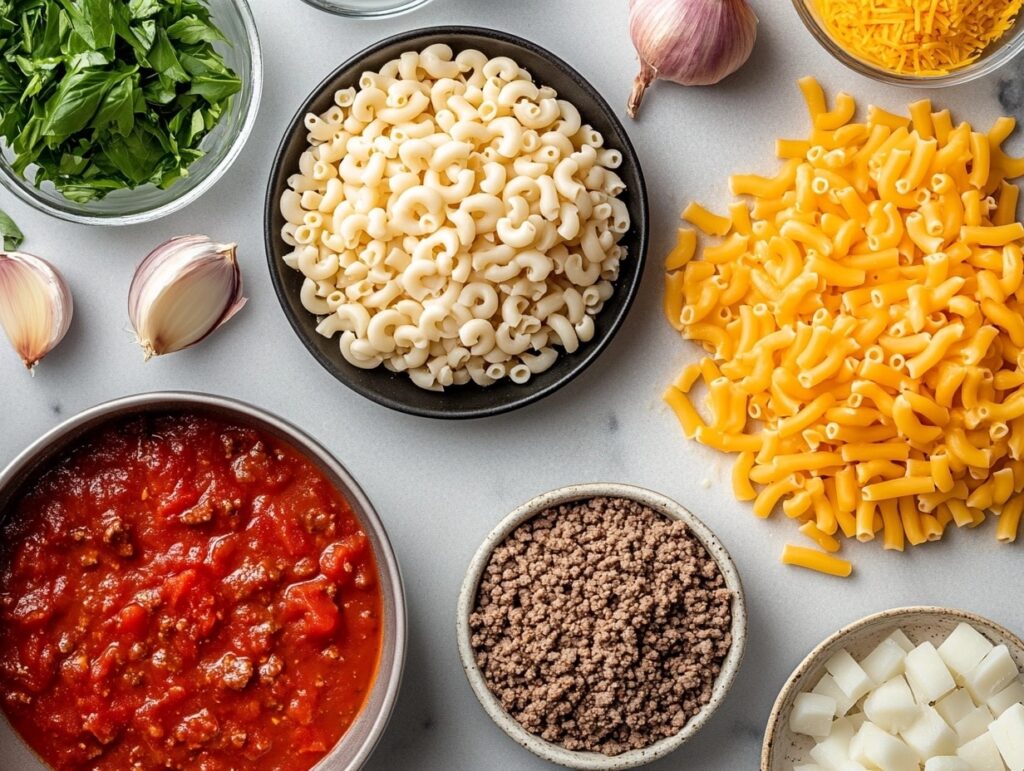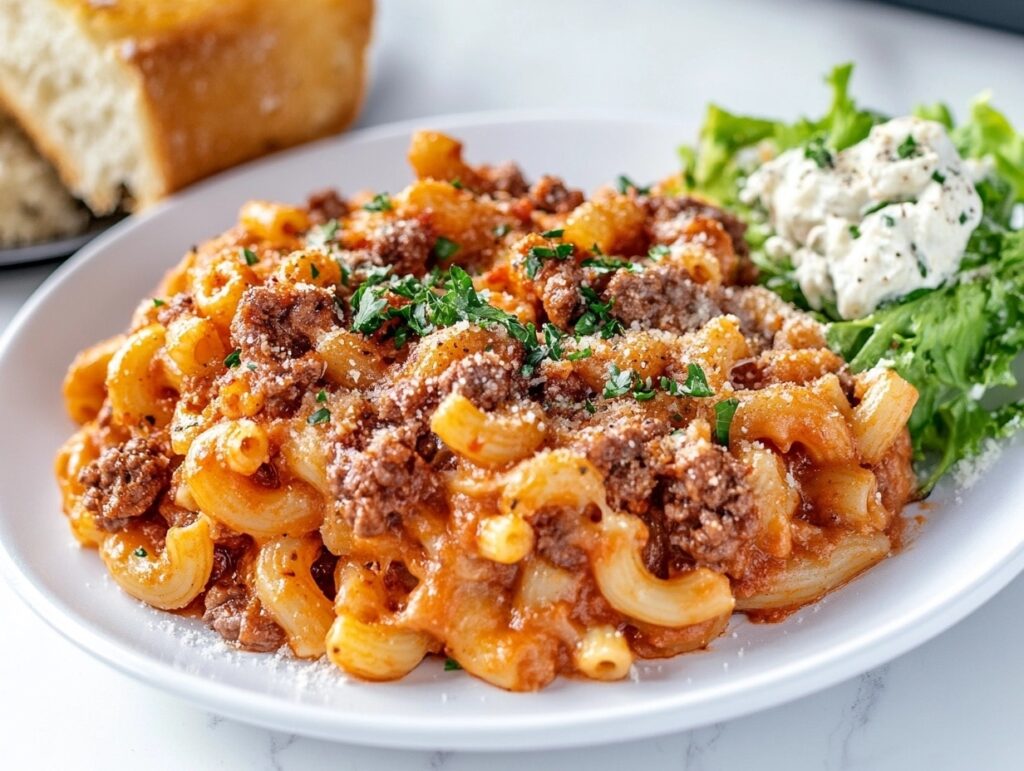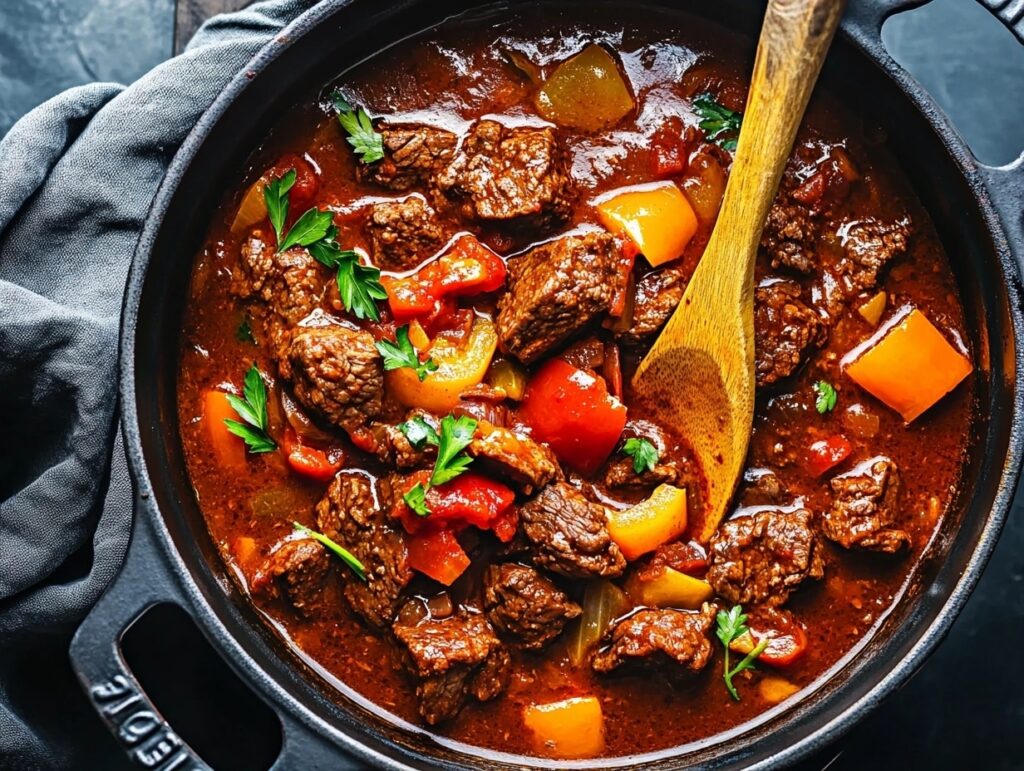Introduction to Beefaroni and Goulash
Let’s face it: nothing hits the spot quite like a warm bowl of hearty comfort food. But when it comes to beefaroni and goulash, do you know the difference? At first glance, these two dishes may seem interchangeable. Both feature pasta, meat, and sauce, right? Well, not so fast. While they share some similarities, these dishes hail from different culinary traditions and have unique personalities that make them shine in their own ways.
Beefaroni is the quintessential American weeknight dinner, simple and satisfying. Goulash, on the other hand, is a rich and flavorful dish deeply rooted in Hungarian cuisine. Curious yet? Let’s dive deeper and uncover what truly sets these comfort classics apart.
Table of contents
The Origins of Beefaroni and Goulash
Historical Background of Beefaroni
Beefaroni has an endearing, almost nostalgic charm. Originally popularized in the mid-20th century, it emerged as a quick, easy-to-make dish for busy families. The concept of beefaroni was heavily influenced by Italian-American cuisine, but let’s be honest, it’s not something you’ll likely find on a menu in Rome. Instead, think of it as a mashup of spaghetti Bolognese and mac and cheese.
Chef Boyardee famously brought beefaroni to the masses, cementing it as a pantry staple for decades. Its affordability, ease of preparation, and kid-friendly flavor made it a go-to option during economic hard times and beyond.
“Beefaroni is like a warm hug from the pantry—quick, comforting, and always there when you need it.”
The Rich Culinary History of Goulash
Goulash takes us on a journey to Central Europe, where it originated as a Hungarian dish called gulyás. Dating back to the 9th century, goulash was initially a meal for shepherds. Its name is even derived from the Hungarian word for “herdsman.” Traditionally, it was a stew made with slow-cooked beef or lamb, vegetables, and a generous dose of paprika—a hallmark of Hungarian flavors.
Over the centuries, goulash spread across Europe, adapting to local tastes and ingredients. Today, there are endless regional variations, from thick stews to more soupy versions. However, the essence of goulash remains unchanged: it’s a heartwarming dish that speaks to its rustic, communal roots.
Ingredients: What Sets Them Apart?
When you take a closer look, the differences in ingredients between beefaroni and goulash become crystal clear. Let’s break it down.
Key Ingredients in Beefaroni

Beefaroni is a straightforward affair. At its core, it’s all about:
| Ingredient | Quantity |
|---|---|
| Ground beef | 1 pound |
| Elbow macaroni | 2 cups |
| Tomato sauce | 2 cups |
| Cheddar cheese | 1 cup (shredded) |
| Onion | 1 small (chopped) |
| Garlic | 2 cloves (minced) |
| Italian seasoning | 1 tsp |
These ingredients combine to create a meal that’s creamy, tangy, and oh-so-satisfying. The pasta soaks up the sauce, while the beef adds a hearty texture.
Key Ingredients in Goulash
Goulash is a bit more complex, relying on layers of flavor from a diverse array of ingredients:
| Ingredient | Quantity |
|---|---|
| Beef chuck | 1 pound (cubed) |
| Paprika | 2 tbsp |
| Onion | 2 large (diced) |
| Garlic | 3 cloves (minced) |
| Bell peppers | 1 cup (sliced) |
| Tomatoes | 2 cups (diced) |
| Beef broth | 4 cups |
| Caraway seeds | 1 tsp |
| Sour cream | Optional, for garnish |
Notice the heavy use of paprika and caraway seeds in goulash? These spices are what give the dish its signature Hungarian flair. The slow cooking process melds the flavors together, creating a rich, aromatic experience.
Cooking Methods: Similarities and Differences
If you’ve ever wondered why these dishes taste so different, much of it comes down to how they’re prepared.
How Beefaroni is Prepared
Cooking beefaroni is as simple as it gets. Brown your ground beef and onions, toss in some tomato sauce and seasonings and let it simmer. Once the flavors marry, add cooked macaroni and stir it. Sprinkle some cheese on top, and voilà! Dinner is served in under 30 minutes.
It’s this simplicity that makes beefaroni such a lifesaver for busy weeknights. No fancy techniques, no endless waiting—just hearty, delicious food.
Traditional Techniques for Making Goulash
Goulash, however, is all about patience. It’s typically cooked in a heavy pot or Dutch oven. The process starts by sautéing onions until golden, then adding beef and paprika. From there, the dish is slowly simmered with broth, tomatoes, and spices. This allows the meat to become tender and the flavors to develop fully.
“Goulash isn’t just a meal—it’s an event. It invites you to slow down, savor, and share.”
Unlike beefaroni, which is quick and casual, goulash rewards those who put in the time and effort.
Flavor Profiles: How Do They Compare?
One of the most fascinating differences between beefaroni and goulash lies in their flavor profiles. These two dishes may look similar on the surface, but their tastes are worlds apart.
The Unique Taste of Beefaroni
Beefaroni’s flavor is simple and comforting. The savory richness of ground beef blends perfectly with the tangy sweetness of tomato sauce. Add in some melted cheddar, and you have a dish that’s creamy and satisfying with every bite. It’s not overly spicy or complex, which is part of its charm—it’s designed to be approachable and universally loved.
Think of beefaroni as the culinary equivalent of a cozy sweater. It’s not trying to wow you with bold flavors; instead, it’s here to offer reliable comfort. Whether you’re a picky eater or an adventurous foodie, beefaroni’s straightforward profile rarely disappoints.
What Defines the Flavor of Goulash?
Goulash, on the other hand, is an explosion of layered flavors. Paprika is the star ingredient, lending its smoky, slightly sweet heat to the dish. The slow cooking process allows the beef to soak up the spices and broth, creating a deep, robust taste that’s both hearty and complex.
But goulash doesn’t stop there. The addition of caraway seeds, onions, and bell peppers brings earthy and slightly sweet undertones, while the optional sour cream garnish adds a tangy creaminess that balances the spices. It’s a dish that asks for your attention with its bold, aromatic flavors.
If beefaroni is a cozy sweater, goulash is like a well-tailored coat—structured, intricate, and meant to make an impression.
Cultural Significance of Beefaroni and Goulash
Food is more than just sustenance; it tells a story. Beefaroni and goulash each carry cultural weight that makes them more than just tasty meals.
Beefaroni in Modern Cuisine
Beefaroni is a quintessentially American dish. It represents the post-World War II era, when convenience and affordability were paramount in home cooking. The rise of canned foods and one-pot meals made dishes like beefaroni an integral part of the American diet.
Today, beefaroni is a nostalgic favorite. It reminds people of simpler times—childhood dinners, school lunches, or quick meals before soccer practice. Its association with Chef Boyardee has cemented its place in popular culture, making it a household name.
“Beefaroni isn’t just food; it’s a slice of American culinary history.”
Goulash as a Cultural Staple
Goulash holds a much deeper cultural significance. In Hungary, it’s more than just a meal—it’s a national treasure. Traditionally prepared for communal gatherings, goulash symbolizes hospitality and togetherness. It’s a dish that brings people together, whether shared at a family table or served at a festival.
Beyond Hungary, goulash has become a beloved dish across Europe. Variations can be found in Austria, Germany, and even Poland, each adapted to local tastes. Despite these changes, goulash’s essence remains tied to its Hungarian roots and the warmth of its shared heritage.
Nutritional Comparison of Beefaroni and Goulash
When deciding between beefaroni and goulash, nutrition may play a role. Let’s take a closer look at how they stack up.
| Nutrient | Beefaroni (Per Serving) | Goulash (Per Serving) |
|---|---|---|
| Calories | 450 | 350 |
| Protein | 20g | 25g |
| Fat | 15g | 10g |
| Carbohydrates | 50g | 30g |
| Sodium | 900mg | 700mg |
Health Benefits of Beefaroni
Beefaroni’s nutritional profile makes it a solid choice for a quick energy boost. The combination of pasta and beef provides a good mix of carbs and protein, which can help refuel after a long day. However, it’s worth noting that beefaroni is often high in sodium, especially if you’re using canned ingredients. Opting for low-sodium tomato sauce or whole-grain pasta can make it a bit healthier.
Explore What is Beefaroni Made Of? for a detailed breakdown
Is Goulash a Healthier Option?
Goulash tends to be a bit lighter, especially if you use lean cuts of beef and go easy on the sour cream. Its reliance on fresh ingredients like bell peppers and tomatoes also boosts its nutritional value, adding vitamins and antioxidants. Additionally, goulash’s slow-cooked nature means it doesn’t rely on processed ingredients, making it a more wholesome option for health-conscious eaters.
“Goulash is proof that healthy food doesn’t have to skimp on flavor.”
Common Misconceptions About Beefaroni and Goulash
It’s easy to confuse beefaroni and goulash, especially if you haven’t had the chance to try both. However, they’re far from identical. Let’s clear up some of the most common myths surrounding these dishes.
Are They Interchangeable Dishes?
One common misconception is that beefaroni and goulash are the same dish with different names. While they share some ingredients—like beef and pasta—they’re fundamentally different in flavor, preparation, and cultural roots. Swapping one for the other in recipes would yield drastically different results.
Beefaroni thrives on its creamy, cheesy simplicity, while goulash’s rich, paprika-heavy flavor profile gives it an entirely different character. Think of them as cousins rather than twins.
Addressing Myths and Misunderstandings
Another frequent mix-up involves their origin stories. Some people assume beefaroni is a European dish, but it’s an American creation inspired by Italian pasta dishes. Meanwhile, goulash is undeniably Hungarian, with deep cultural ties to Central Europe.
“Calling beefaroni and goulash the same is like confusing pizza with quiche—they’re both great, but they’re not even close to identical!”
Variations and Regional Twists
Both beefaroni and goulash have evolved over time, leading to numerous variations that cater to different tastes and preferences.
Popular Variations of Beefaroni
Beefaroni is as versatile as it gets. Here are some popular spins on the classic:
- Vegetarian Beefaroni: Swap the ground beef for lentils or plant-based meat for a veggie-friendly take.
- Mexican-Style Beefaroni: Add taco seasoning, black beans, and corn, then top with Monterey Jack cheese.
- Baked Beefaroni: Pour the dish into a casserole, sprinkle with extra cheese, and bake until bubbly.
These variations prove that beefaroni can easily adapt to your flavor cravings or dietary needs.
Regional Goulash Recipes from Around the World
Goulash, too, has its share of adaptations. Here are a few regional variations:
- Austrian Goulash: Often thicker and less soupy, this version includes potatoes for added heartiness.
- German Goulash: Frequently made with wine and caraway seeds for a deeper, more robust flavor.
- American Goulash: A hybrid dish that combines ground beef, macaroni, and tomato-based sauce—closer to beefaroni than traditional goulash.
These variations highlight goulash’s global appeal while retaining its Hungarian roots.
Pairing and Serving Suggestions
What’s the perfect side dish to complement beefaroni or goulash? Let’s explore some delicious options.
Best Sides to Serve with Beefaroni

Beefaroni’s mild flavor pairs well with simple, classic sides. Consider:
- Garlic Bread: A crunchy, buttery side that’s perfect for scooping up extra sauce.
- Caesar Salad: The crispness of romaine and tangy dressing balances beefaroni’s richness.
- Steamed Veggies: Broccoli, carrots, or green beans add a nutritious touch.
These sides enhance the meal without overpowering it.
Complementary Pairings for Goulash
For goulash, you’ll want sides that highlight its bold flavors. Try these:
- Crusty Bread: Ideal for soaking up the savory broth.
- Cucumber Salad: A refreshing counterpoint to goulash’s hearty spices.
- Mashed Potatoes: A creamy, comforting base for the stew.
“Pairing the right sides with your main dish is like finding the perfect accessory for your outfit—it elevates the whole experience!”
Practical Tips for Cooking Both Dishes
Whether you’re a beginner or a seasoned cook, these tips will help you master beefaroni and goulash.
Cooking Beefaroni for Beginners
- Use Fresh Ingredients: Fresh garlic and onions make a big difference in flavor.
- Don’t Overcook the Pasta: Keep it al dente so it doesn’t turn mushy when mixed with the sauce.
- Customize Your Cheese: Experiment with mozzarella, parmesan, or even a mix of cheeses for a unique twist.
With these tips, your beefaroni will be a hit every time.
Perfecting Goulash: Expert Advice

- Invest in Quality Paprika: Since it’s the star ingredient, splurge on high-quality Hungarian paprika.
- Go Low and Slow: Allow the dish to simmer for at least an hour to develop its signature depth of flavor.
- Balance the Spices: Taste as you go, and don’t be afraid to adjust the seasoning to suit your palate.
Goulash may take a little more effort, but the payoff is absolutely worth it.
FAQs About Beefaroni and Goulash
What’s the main difference between beefaroni and goulash?
Beefaroni is an American pasta dish with a cheesy, tomato-based sauce, while goulash is a Hungarian stew featuring beef, paprika, and vegetables.
Can I use different types of pasta in beefaroni?
Absolutely! While elbow macaroni is traditional, you can use shells, penne, or any pasta shape you prefer.
Is goulash always spicy?
Not necessarily. While paprika adds a mild heat, you can adjust the spice level to your liking.
Can I make beefaroni ahead of time?
Yes! Beefaroni stores well in the fridge and can be reheated easily, making it great for meal prep.
What cuts of beef work best for goulash?
Beef chuck or stewing beef are ideal because they become tender when cooked slowly.
Is goulash gluten-free?
Traditional goulash is gluten-free if served without bread or pasta, but always check ingredients like broth for hidden gluten.
Conclusion: Distinct Yet Delicious Dishes
At the end of the day, beefaroni and goulash are two sides of the same comforting coin. Beefaroni is quick, cheesy, and nostalgic, while goulash is rich, aromatic, and steeped in history. Whether you’re craving a quick fix or an intricate culinary adventure, these dishes have something to offer.
To dive deeper into comfort foods, visit Easy Chicken Broccoli Rice Casserole That Will Wow Your Family for another delicious option.
Why not try making both and see for yourself? After all, the best way to settle the debate is to let your taste buds decide. Happy cooking! 🍽️

